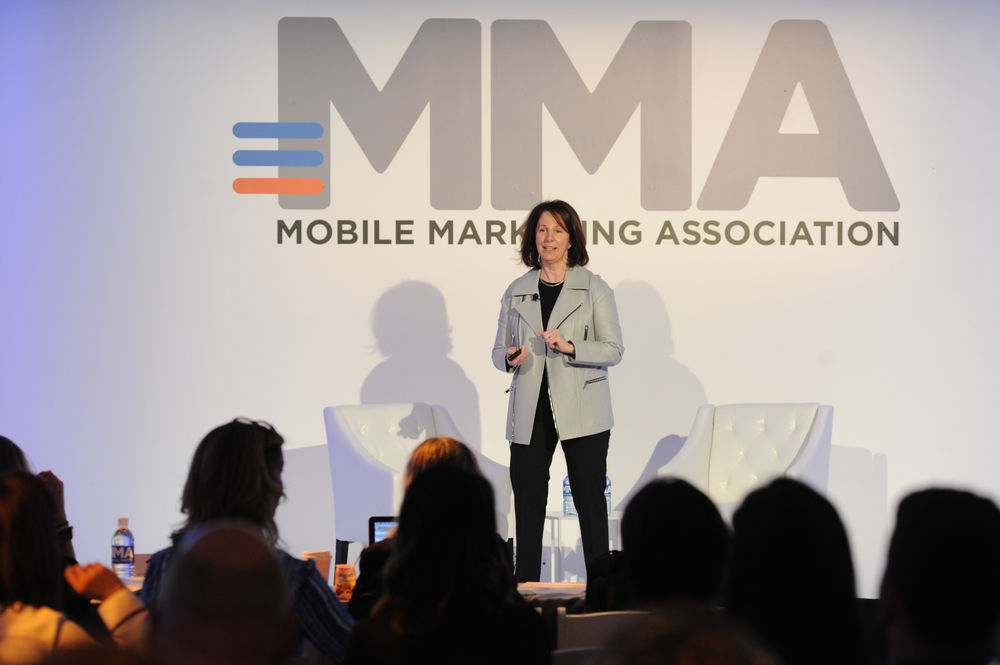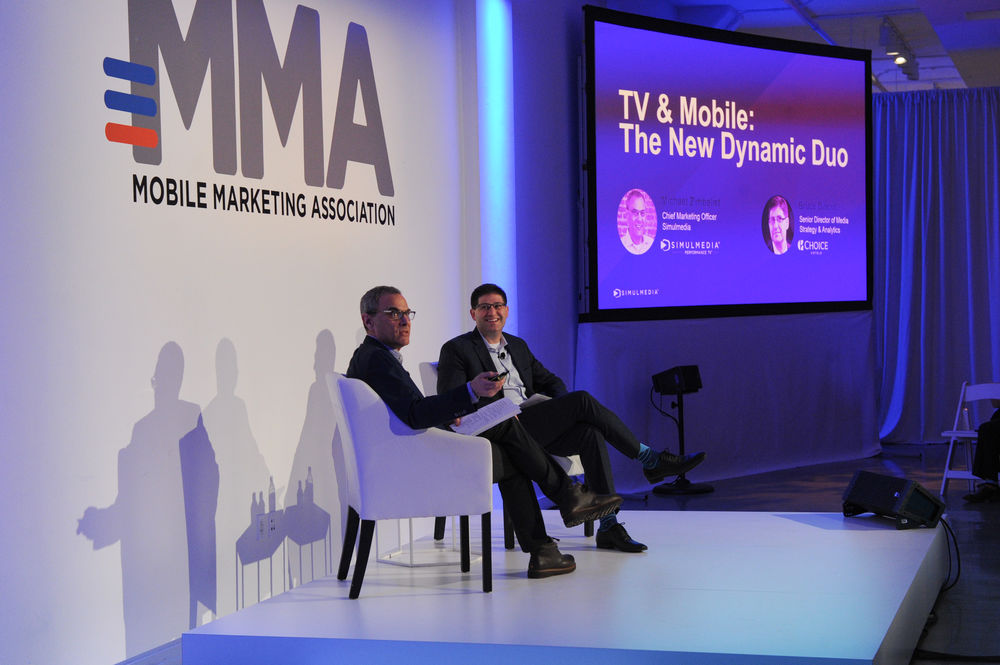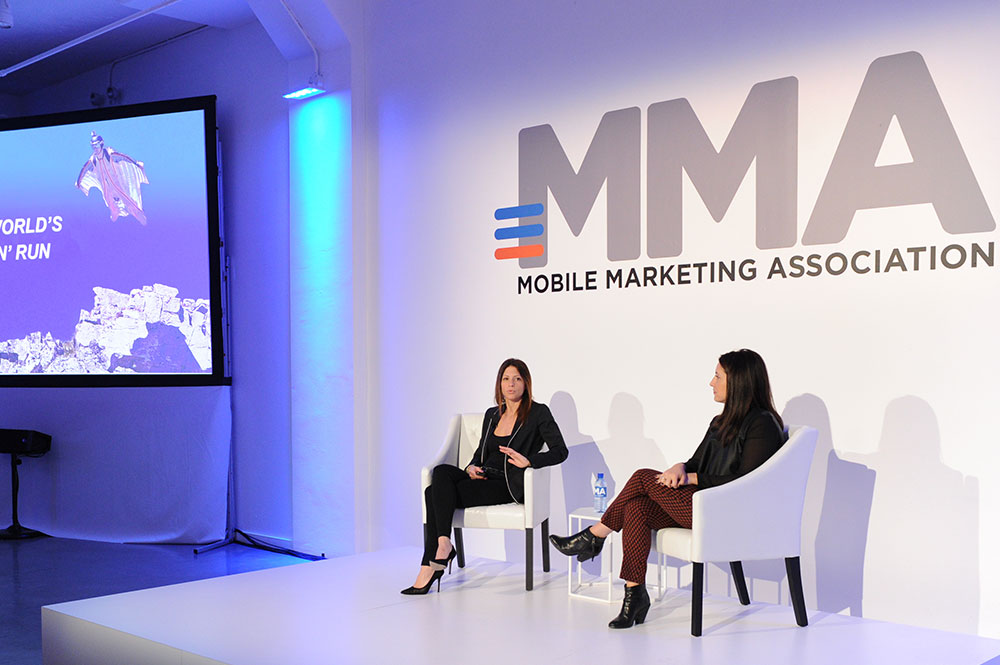Photos from MMA Video Leadership Forum
Click to view full gallery
The Mobile Marketing Association’s first-ever Mobile Video Leadership Forum – held in New York at Metropolitan West -- proved an opportunity not only to look at mobile video’s rapid growth, but more importantly, to look at the inspiration it is giving marketers. While video has been core to marketing for decades because of its unrivaled sight, sound and storytelling capabilities, speakers noted that in mobile, it is a whole new ballgame. Marketers can play with everything from six-second video to live streaming to augmented and virtual reality. In fact, mobile video has an application for just about every marketer; it’s a matter of discovering what is right for an individual brand.
While the insights from presenters were many, this summary distills the day down to five takeaways that the MMA hopes will help you focus your mobile video ad strategy.
- Your competitors will be spending more on mobile video – and you probably will too.
During his opening remarks, Joe Prucz, head of revenue at Rubicon Project, noted that by the end of 2017, 55 percent of all programmatic video dollars are expected to be spent in mobile, surpassing desktop for the first time. (Source: eMarketer)
During his presentation, Rubicon Tom Kershaw said that digital as a whole is expected to surpass TV this year as well, making 2017 a true watermark. Also citing statistics from eMarketer, he said that digital spending is expected to reach $83 billion by year-end, compared with just over $72 billion for TV. By 2020, the two mediums paths will have greatly diverged, with digital accounting for 62 percent of overall spending at more than $129 billion.
The growth isn’t just a factor of the increasing time people are spending with their mobile devices. As Prucz pointed out, brand marketers are gravitating toward programmatic mobile video because it is a highly efficient way to spend across a fragmented app economy, it can manage all types of video formats, and, of course, it provides data to more precisely reach each member of a marketer’s target audience.
- Think about the uniqueness of the mobile platform. It’s mobile, not TV.
 Of course, it’s inevitable that any discussion of video, ends up in a comparison with TV. That said – while many advertisers repurpose their 15- or 30- second commercials for desktop and mobile -- speakers were adamant about how different the mobile environment is. In her opening keynote, titled, “Target’s Evolution to 1-Second Storytelling”, the retailer’s Senior Vice President, Media and Guest Engagement, Kristi Argyilan, walked attendees through the evolution of “This Just In,” a weekly video series focusing on Target products. “Our digital video presence wasn’t really meeting what our guest desired,” she said. “To be timely and relevant we really needed to change our approach to video overall.”
Of course, it’s inevitable that any discussion of video, ends up in a comparison with TV. That said – while many advertisers repurpose their 15- or 30- second commercials for desktop and mobile -- speakers were adamant about how different the mobile environment is. In her opening keynote, titled, “Target’s Evolution to 1-Second Storytelling”, the retailer’s Senior Vice President, Media and Guest Engagement, Kristi Argyilan, walked attendees through the evolution of “This Just In,” a weekly video series focusing on Target products. “Our digital video presence wasn’t really meeting what our guest desired,” she said. “To be timely and relevant we really needed to change our approach to video overall.”
The retailer rented a house nearby its headquarters so it could be an ongoing set for the series, and has even featured Target employees as the spokespeople; purchase lift among featured products is up 18 percent.
But despite the effort’s success so far, there has been a learning curve, as Target figured out how to better entice mobile users. While early episodes of “This Just In” featured a handful of products – from planters to makeup removers – and extended over a full two minutes, the brand soon learned it had to cut to the chase faster. To give viewers a preview of what each video would focus on, “This Just In” now features four products within the first ten seconds and the videos aren’t quite as long. “The shorter we got, the more that we put the products upfront, the higher return,” she said.
But there are other things to keep in mind about what makes mobile video different than video on other platforms. This became clear in a group presentation featuring Flipboard’s Senior VP/Global Advertising Partnerships Christine Cook, John Hardy’s Vice President/Global Digital Audrey Anna Yu and Rubicon SVP/Head of Video John Peragine. They highlighted the need to respect the user, the content and the brand when serving video content on such a personal device. Cook explained that Flipboard’s approach to video content is for it to be personally relevant, politely introduced, user-initiated and full screen. She said, “Consumers are in personal prime time” on mobile; publishers and marketers that use video need to be mindful of that.
Advertisers who observe mobile video’s differences can expect rewards. When jeweler John Hardy advertised on Flipboard, it saw a 1.43% engagement rate, which was not only more than 1.5 times the company’s internal benchmark, but 2.5 times the industry benchmark.
- Think about being Netflix or Amazon, using your data to create content that resonates.
No marketing conference is complete without a discussion of data, and at the Mobile Video Leadership Forum, Rahul Telang, Professor of Information Systems at Carnegie Mellon University’s Heinz College brought it front and center. But his talk wasn’t about using data for targeting media more effectively, but for producing creative that resonates better with the target.
Telang, who co-authored the book Streaming Sharing Stealing: Big Data and the Future of Entertainment with Michael D. Smith, noted how technology players such as Netflix and Amazon have been so successful at creating entertainment content; they’ve done it by having vast stores of first-party data that reveal consumer preferences -- and they also have taken advantage of a revolutionized business model that has leveled the playing field when it comes to distribution.
Just as some of the new entertainment/technology companies have, Telang sees opportunity for marketers – because they also have vast storehouses of data and can also leverage new distribution models that don’t rely on a scarce number of outlets. It’s all part of a shift from “gut-feel” entertainment and marketing content to data-driven content.
How do marketers get there? Telang suggested that companies need to organize around data, because data is most useful when it is linked together, which in turn increases the effectiveness of analytics talent, makes such talent easier to retain and also increases objectivity. Another key: having the analytics team sit right within the business unit, rather than being ancillary to the organization.
- Take time to look at how mobile performs in the context of other channels and how different mobile formats perform against one another.
 Several speakers emphasized the need to look at how mobile video works in context, since most channels and formats usually don’t perform in isolation. Marketers need to study the role of different components of a campaign to figure out what is contributing to the overall business outcome. The results may be surprising.
Several speakers emphasized the need to look at how mobile video works in context, since most channels and formats usually don’t perform in isolation. Marketers need to study the role of different components of a campaign to figure out what is contributing to the overall business outcome. The results may be surprising.
A study looking at how TV and Facebook perform together, presented by Simulmedia CMO Michael Zimbalist and Choice Hotels Senior Director/Media Strategy and Analytics Bruce Dincin, emphasized the point. The study illustrated that few people had actually seen a recent Choice campaign on more than one platform, despite it being a cross-screen effort. Within the panel of slightly more than 300,000 people, 62.4 percent were exposed to it only on TV, and .8 percent only saw it on Facebook. Two percent said they saw the campaign on both platforms, but the startling finding was that the group played a hugely outsized role in the campaign’s effectiveness -- their conversion rate was almost 15 percent. Those who saw the campaign on Facebook alone had a 4.7 percent conversion rate, and those who just saw it on TV had a one percent conversion rate.
While TV still drives the most conversions for Choice, the research has also underscored the need to orchestrate improved cross-media activation in future campaigns, noted Dincin. “TV investment [for this campaign] was much higher. We need to divide the money up more,” he said.
Rex Briggs, founder and CEO of Marketing Evolution, emphasized the importance of looking at how different formats within the mobile channel perform to get a better handle on how marketers can make the most of their mobile investment. Across the ten MMA SMoX studies performed so far, mobile video has proven that it is worth the premium it commands, because it has been shown to perform better than mobile banners, full screen mobile, mobile audio and mobile native. Drilling down further, he revealed how different mobile video formats perform differently. In one SMoX study, pre-roll, in-stream video was 78 percent better in delivering on consideration per dollar spent than an opt-in video banner.
Perhaps the biggest finding from SMoX is that marketers routinely underinvest in mobile. Said Briggs, “The optimal allocation suggests [mobile] should be seventeen percent of the mix, about three times the current investment."
- Don’t forget to experiment. Mobile video isn’t one-size-fits-all, but is a number of different opportunities ranging from FB Live to Virtual Reality to six-second video.
 Most of the brands on stage at the Mobile Video Leadership Forum talked about the need to experiment, and even those that are on the forefront of mobile expressed the desire to experiment more.
Most of the brands on stage at the Mobile Video Leadership Forum talked about the need to experiment, and even those that are on the forefront of mobile expressed the desire to experiment more.
Of all the creative shown at the Forum, however, none was as daring as the #WTFast campaign for Dunkin’ Donuts, which was created to promote its on-the-go ordering – the chain’s biggest operational change since drive-thru -- and encourage users to re-download its new mobile app. (The campaign also won “Best in Show” at 2016’s Global Smarties Awards.) The brief? “To go do something batshit crazy, and do something that Dunkin’ hasn’t done before,” said Sherrill Kaplan, VP/Digital Marketing & Innovation at Dunkin’ Brands. The solution -- from DigitasLBI’s Julie Blanche and her team -- was to hire Wingsuit BASE Jumper Ellen Brennan to fly in a custom Dunkin’ Donuts-branded fly suit and catch a Dunkin’ order literally as she was flying by a Dunkin’ store built for the shoot on a mountain in Chamonix, France – at 120 mph. “It was very very different from what our advertising team usually puts out,” Kaplan said.
Dunkin’ doubled down on mobile for the campaign, spending approximately 70 percent of the budget on it, and leveraging mobile tactics and targeting on social platforms including Facebook, Twitter and Instagram along with digital video targeted to mobile devices on YouTube and through programmatic media. Dunkin’ was one of the first advertisers to use "swipe up" to download ads on Snapchat.
The campaign gave the brand opportunities it wouldn’t otherwise have had. It deployed 360-degree ads on Facebook and YouTube to give users a virtual reality experience of Brennan’s jumps, leveraged her own channels to boost the campaign, and amplified the campaign further when GoPro and extreme sports fanatics began to show interest. The integrated campaign tallied more than 11 million views in just the first two weeks after launching, resulting in more than 134 million impressions and a 44 percent increase in new app users. In total, the #WTFast campaign has generated 155 million views of the digital videos, making it DD's most watched digital video campaign to date.
The advice from Kaplan and Blanche: Do not forget about sustaining the campaign; stagger your narrative; and do not lose momentum on a moment in time.
Dhanusha Sivajee, Executive VP/ Marketing and Editorial of XO Group – which produces lifestyle properties The Nest, The Bump and The Knot -- noted that, “Mobile is the new campfire. People are actually gathering around mobile devices.” XO feels that video is central to tapping into that insight, and thus has experimented with video in ways it sometimes found surprising. It has had unexpected success with FB Live, which it uses for Q&As with its editors, and has also been employing virtual reality – using Google Cardboard – to give its audience tours of places for destination weddings and what it might be like to experience a wedding in 360.
That said, those with a lot of experience in experimentation urged taking it slowly. Jarrett Dube, Senior Director/Head of Creative Brand Marketing at Samsung touted all the brand has learned as makers of the Gear VR headset, which range from a partnership with The New York Times to creating an experience that is part of the story on Fox’s “24: Legacy.” “Trying to rush things, is a mistake,” he said. “Is it the right story? Is it going to work in VR?”
The MMA wishes to thank all of the speakers and attendees and sponsors.
Join us at the MMA Location Leadership Forum on Apr 5 in New York, featuring speakers from companies including Wendy’s, PepsiCo and Volvo. For more on this event, click here.
We’d also love to see you at the annual MMA Mobile Marketing Leadership Forum on May 9 – 10 in New York. Speakers include The Coca-Cola Company, Twitter, Budweiser, Grubhub and more. For details, click here.
Other events in the MMA Forum Series you may be interested in:
 Of course, it’s inevitable that any discussion of video, ends up in a comparison with TV. That said – while many advertisers repurpose their 15- or 30- second commercials for desktop and mobile -- speakers were adamant about how different the mobile environment is. In her opening keynote, titled, “Target’s Evolution to 1-Second Storytelling”, the retailer’s Senior Vice President, Media and Guest Engagement, Kristi Argyilan, walked attendees through the evolution of “This Just In,” a weekly video series focusing on Target products. “Our digital video presence wasn’t really meeting what our guest desired,” she said. “To be timely and relevant we really needed to change our approach to video overall.”
Of course, it’s inevitable that any discussion of video, ends up in a comparison with TV. That said – while many advertisers repurpose their 15- or 30- second commercials for desktop and mobile -- speakers were adamant about how different the mobile environment is. In her opening keynote, titled, “Target’s Evolution to 1-Second Storytelling”, the retailer’s Senior Vice President, Media and Guest Engagement, Kristi Argyilan, walked attendees through the evolution of “This Just In,” a weekly video series focusing on Target products. “Our digital video presence wasn’t really meeting what our guest desired,” she said. “To be timely and relevant we really needed to change our approach to video overall.” Several speakers emphasized the need to look at how mobile video works in context, since most channels and formats usually don’t perform in isolation. Marketers need to study the role of different components of a campaign to figure out what is contributing to the overall business outcome. The results may be surprising.
Several speakers emphasized the need to look at how mobile video works in context, since most channels and formats usually don’t perform in isolation. Marketers need to study the role of different components of a campaign to figure out what is contributing to the overall business outcome. The results may be surprising. Most of the brands on stage at the Mobile Video Leadership Forum talked about the need to experiment, and even those that are on the forefront of mobile expressed the desire to experiment more.
Most of the brands on stage at the Mobile Video Leadership Forum talked about the need to experiment, and even those that are on the forefront of mobile expressed the desire to experiment more.